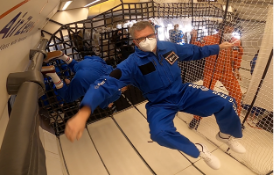
[tta_listen_btn listen_text=”Click to listen to this story” pause_text=”Pause” resume_text=”Resume” replay_text=”Replay” start_text=”Start” stop_text=”Stop”]
To help inform more inclusive astronaut training, Professor Michael Jenkin from the Department of Electrical Engineering and Computer Science at York University’s Lassonde School of Engineering is gearing up for a project, “The Influence of Partial Gravity on the Perception of Self-Motion: Sex Differences (SMUG-PS),” which specifically focuses on women and their changes in perception of self-motion when exposed to partial gravity.
In space, unusual environments such as zero and partial gravity can significantly alter human perception of self-motion, leading to challenges with self-orientation and visual processing. Effective astronaut training is critical to ensuring survival and mission success. However, current training measures are based on heavily skewed data from human performance studies that concentrate on a very specific group of people.

“People who are trained to go to space fit a very narrow superman type; they’re fit, young, healthy … and usually men,” says Jenkin. “Back in the day, most astronauts were men recruited from the military, but in the present day we want to send all kinds of people to space. We won’t be able to do this if training measures are only developed for a very specific group.”
Most research to date focuses on human responses to zero gravity; however, understanding the effects of partial gravity is becoming increasingly important for developing training methods to prepare astronauts for space missions involving the surface of the moon, Mars or other planets.
SMUG-PS is built on a previously conducted study, “The Influence of Partial Gravity on the Perception of Self-Motion (SMUG-P),” which focused solely on men. “We want to see if women respond differently to partial gravity than men,” says Jenkin. “If they do, we’ll need to change the way we’re training astronauts.”
Female study participants will undergo a series of repeated tests to measure their perceived distance of self-motion while aboard a thrilling, parabolic flight that ascends in a steep, curved pattern to simulate partial gravity conditions. Each test will be performed at various segments of the flight, including before and after, to develop a model of multi-cue integration processes.
Throughout the duration of the study, participants will wear a head-mounted display that simulates a virtual-reality environment, mimicking a long corridor. Participants will be asked to estimate their distance from an indicated target and will then experience a simulated forward motion towards it. When they believe they have reached the target, they are required to press a button. It is expected that this process will be easier said than done, as the partial gravity environment established by the parabolic flight will influence their perception of self-motion.
Results obtained from SMUG-PS will allow for a better understanding of how women process visual information in partial gravity conditions, to address issues in space and on earth. “By extending experiments to women, we can identify changes that need to be made to astronaut training measures to maximize mission success,” says Jenkin. Combined results from SMUG-P and SMUG-PS will also be used to inform the development of training and countermeasures to prepare astronauts for environments governed by partial gravity, thereby improving mission success as well as astronaut health and safety. Ultimately, these projects will be used to produce the first sex-balanced partial gravity perception of self-motion dataset.
In addition, these projects will establish crucial information that can advance global understanding of medical conditions affecting human perception of self-motion. “If we can understand how people respond to altered perception of their environments, we can provide stronger cues, like modifying the lighting or visual appearance of objects in someone’s home,” he says.
SMUG-PS will bring meaningful partnerships to Lassonde, through the collaborative efforts of Professor Robert Allison from Lassonde’s Department of Electrical Engineering and Computer Science, Professor Laurence Harris from York University’s Department of Psychology, as well as Nils-Alexander Bury and Professor Rainer Herpers from Bonn-Rhein-Sieg University of Applied Sciences in Germany.
